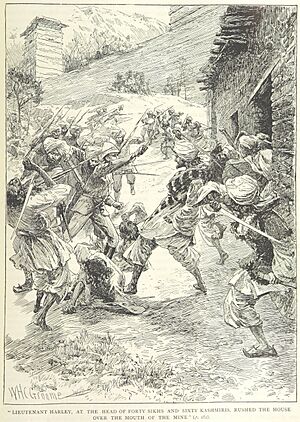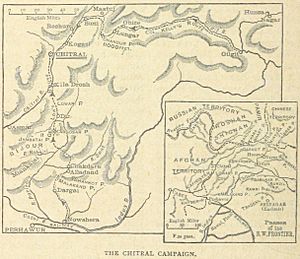Chitral Expedition facts for kids
Quick facts for kids Chitral Expedition |
|||||||
|---|---|---|---|---|---|---|---|
 A skirmish during the Chitral expedition |
|||||||
|
|||||||
| Belligerents | |||||||
| Pro-British Chitralis | Afghans (Ethnic Pashtuns) Chitrali |
||||||
| Commanders and leaders | |||||||
Shuja ul-Mulk |
Umra Khan Sher Afzul Khan Amir ul-Mulk |
||||||
| Strength | |||||||
| 15,249 (Low Force) 1,400 (Fort & Gilgit force) |
unknown | ||||||
| Casualties and losses | |||||||
| 21 killed, 101 wounded (Low force) 165 killed, 88 wounded (Fort & Kelly force) |
unknown but heavy | ||||||
The Chitral Expedition was a military mission in 1895. It was sent by the British government in India to help the fort at Chitral. The fort was under siege, meaning it was surrounded by enemy forces. This happened after a sudden takeover of power in Chitral, following the death of its old ruler. A British force of about 400 soldiers was trapped inside the fort. They were later rescued by two groups of soldiers: a small one from Gilgit and a larger one from Peshawar.
Contents
Why the Conflict Started
In the late 1800s, there was a big competition between the British and Russian empires. This was called the Great Game. Both empires wanted more power and control in Asia. They were especially interested in the mountains north of British India. This area, including Chitral, was seen as a possible path for a Russian invasion of India.
From 1857 to 1892, the ruler of Chitral was Aman ul-Mulk. He was from the Katoor Dynasty. When he died in 1892, his son, Afzal ul-Mulk, quickly took control. He tried to kill his half-brothers to secure his power.
However, Aman ul-Mulk's brother, Sher Afzal Khan, who was living in Afghanistan, secretly came back to Chitral. He murdered Afzal ul-Mulk. Another of Aman ul-Mulk's sons, Nizam ul-Mulk, had escaped to the British in Gilgit. He marched back towards Chitral. Sher Afzal's soldiers even joined Nizam. Seeing he had no chance, Sher Afzal fled back to Afghanistan. Nizam then became the new ruler with British support. A British officer, Lieutenant B.E.M Gurdon, was sent to Chitral.
Less than a year later, Nizam ul-Mulk was murdered by his brother, Amir ul-Mulk, during a hunting trip. Soon after, Umra Khan, a tribal leader from the south, marched north with 3,000 Pathan fighters. He either wanted to help Amir ul-Mulk or take over Chitral himself.
Surgeon Major George Scott Robertson, the main British officer in Gilgit, quickly gathered 400 soldiers. He marched to Chitral and warned Umra Khan to leave. When Amir ul-Mulk started talking with Umra Khan, Robertson decided to replace him. He made Amir's 12-year-old brother, Shuja ul-Mulk, the new ruler.
At this point, Sher Afzal Khan returned to the fight. It seemed the plan was for Sher to become ruler and Umra Khan to get some Chitral land. Robertson and his men moved into the fort for safety. This made the local people even more hostile. As Umra Khan and Sher Afzal continued their march, secret messages were sent out asking for help.
The Siege of Chitral Fort
The Chitral Fort was a strong building, 80 yards square. Its walls were 25 feet high and 8 feet thick, made of mud, stone, and wood. There was a covered path to the river, which was their only water source.
Inside the fort were 543 people. About 343 of them were soldiers, including five British officers. The soldiers were from the 14th Sikhs and a larger group of Kashmiri Infantry. They had two small cannons but only 80 cannonballs. Each soldier had only 300 bullets. They had enough food for about a month.
Trees and buildings stood close to the fort walls. Nearby hills also allowed enemies to shoot into the fort with modern rifles. Captain Charles Townshend was in charge of defending the fort.
On March 3, a group of soldiers left the fort to check how strong the enemy was. They lost 23 men killed and 33 wounded. Harry Frederick Whitchurch received a special medal, the Victoria Cross, for helping the wounded. Around the same time, a small group of British relief soldiers from Gilgit was defeated. Their ammunition and explosives were captured.
By April 5, the Chitrali attackers were very close to the fort walls. On April 7, they set fire to the southeast tower. It burned for five hours but did not fall down. Four days later, the Chitralis began digging a tunnel to blow up the fort. They dug from a nearby house, holding noisy parties to hide the sounds of digging.
When the defenders finally heard the digging, it was almost too late to dig their own tunnel to meet it. So, 100 men rushed out of the fort's eastern gate. They found the tunnel entrance, attacked the diggers with bayonets, blew up the tunnel with explosives, and returned to the fort. They lost eight men in this brave attack.
On the night of April 18, someone outside the fort shouted that the attackers had run away. The next morning, a heavily armed group from the fort went out and found it was true. Kelly's relief force arrived at Chitral on April 20. They found the soldiers who had been trapped in the fort looking like "walking skeletons." The siege had lasted for a month and a half, and 41 defenders had died.
The Relief Missions
When the British government heard about Robertson's difficult situation, they started gathering soldiers near Peshawar. However, they were not in a great hurry at first. They thought Umra Khan would eventually give up. But when the news became more serious, they ordered Colonel James Graves Kelly in Gilgit to act.
Kelly gathered all the soldiers he could. This included 400 Sikh Pioneers (who were mostly road-builders), 40 Kashmiri sappers with two small mountain cannons, and 900 Hunza Irregular fighters. These were all strong mountain men. He also hired many coolies to carry supplies. Even though his force was small, Kelly had an advantage. The Chitralis did not think anyone would be brave enough to cross 150 miles of mountains in late winter.
Kelly left Gilgit on March 23. By March 30, he had crossed the snowline at 10,000 feet. Seeing the tough conditions, the coolies tried to run away with their loaded ponies. But they were quickly caught and kept under guard. The biggest challenge was the 12,000-foot Shandur Pass. Kelly's men crossed it between April 1 and 5, pulling the mountain cannons on sledges through waist-deep snow. Fighting began the next day when the Chitralis realized they were coming. By April 13, Kelly's force had pushed the enemy out of two main positions. By April 18, the enemy seemed to have disappeared.
Meanwhile, the British had gathered a huge force of 15,000 men at Peshawar. This army was led by Major-General Sir Robert Low. Brigadier General Bindon Blood was his Chief of Staff. Low's army set off about a week after Kelly left Gilgit.
On April 3, Low's forces bravely attacked the Malakand Pass. This pass was defended by 12,000 local warriors. There were more big fights on April 5 and April 13. On April 17, Umra Khan's men prepared to defend his palace at Munda. But when they saw how many British soldiers there were, they secretly slipped away. Inside the palace, the British found a letter from a Scottish company offering Maxim guns and revolvers for sale. The company was ordered to leave India.
Low's army was still crossing the Lowari Pass on the day Kelly entered Chitral. Even though Kelly reached Chitral first, it was the huge size of Low's army that made the enemy retreat. The first person from Low's force to reach Chitral was Francis Younghusband. He rode ahead of the troops without permission. That night, Younghusband, Robertson, and Kelly shared the fort's very last bottle of brandy.
What Happened Next

Umra Khan escaped with eleven mule-loads of treasure and reached safety in Afghanistan. Sher Afzul ran into one of his enemies and was sent away to live in India.
Many people involved were honored for their bravery. Robertson was made a Knight. Kelly became a special helper to the Queen and received a high honor. Eleven soldiers received the Distinguished Service Order (DSO) medal. Whitchurch received his Victoria Cross. All soldiers who defended the fort were given six months extra pay and three months leave. Townshend later became a Major General. At least nine other participants became Generals.
There was talk of building a road from Peshawar to Chitral. But this idea was rejected because it would be too expensive. Also, the British worried that the Russians could use the road too. Instead, two groups of soldiers were stationed at Chitral and two at the Malakand Pass. In 1898, a British officer learned that the Russians had planned to take over Chitral if the British left it.
British and Indian Army soldiers who took part in the expedition received the India Medal. It had a special badge that said either "Defence of Chitral 1895" or "Relief of Chitral 1895."
Chitral remained peaceful after 1895. Shuja ul-Mulk, the 12-year-old boy made ruler by Robertson, ruled Chitral for the next 41 years until he died in 1936.
Images for kids
-
India Medal with Relief of Chitral clasp
See also
- Chitral Fort
- Category:British military personnel of the Chitral Expedition







